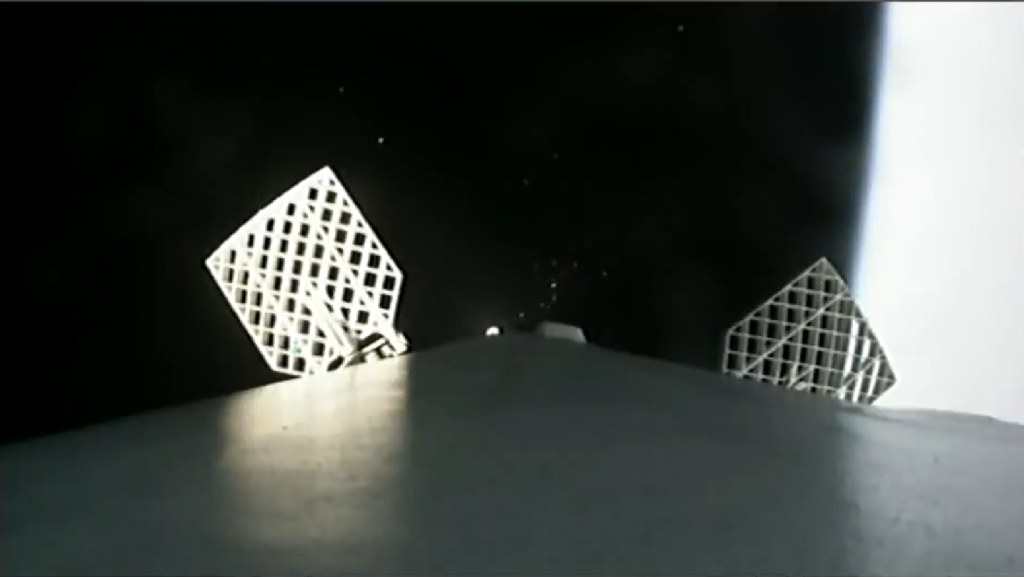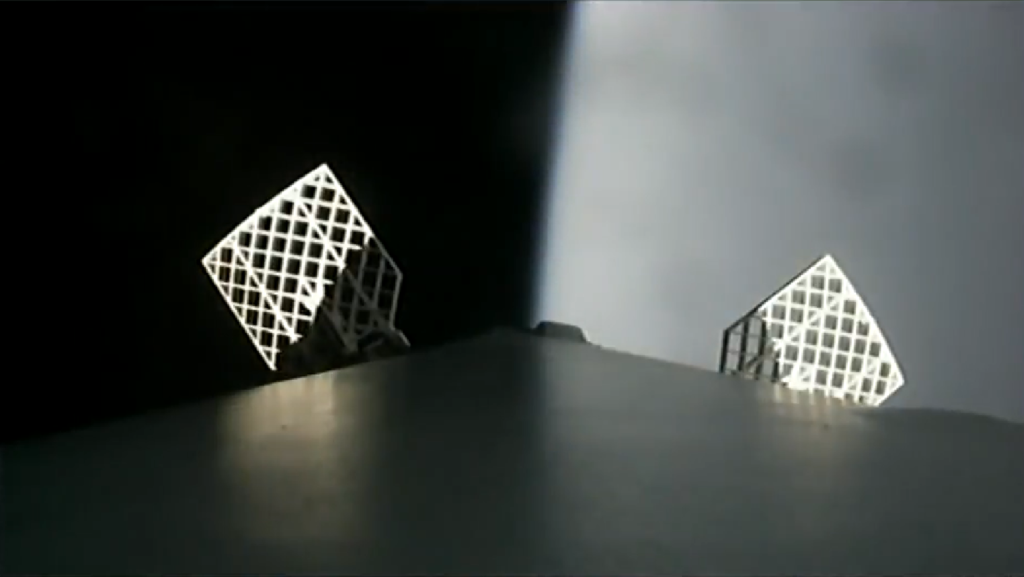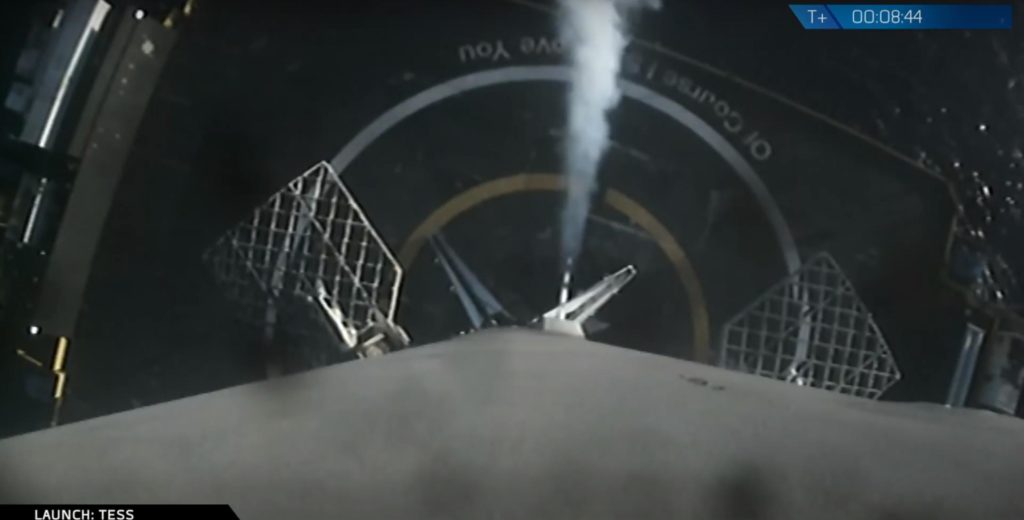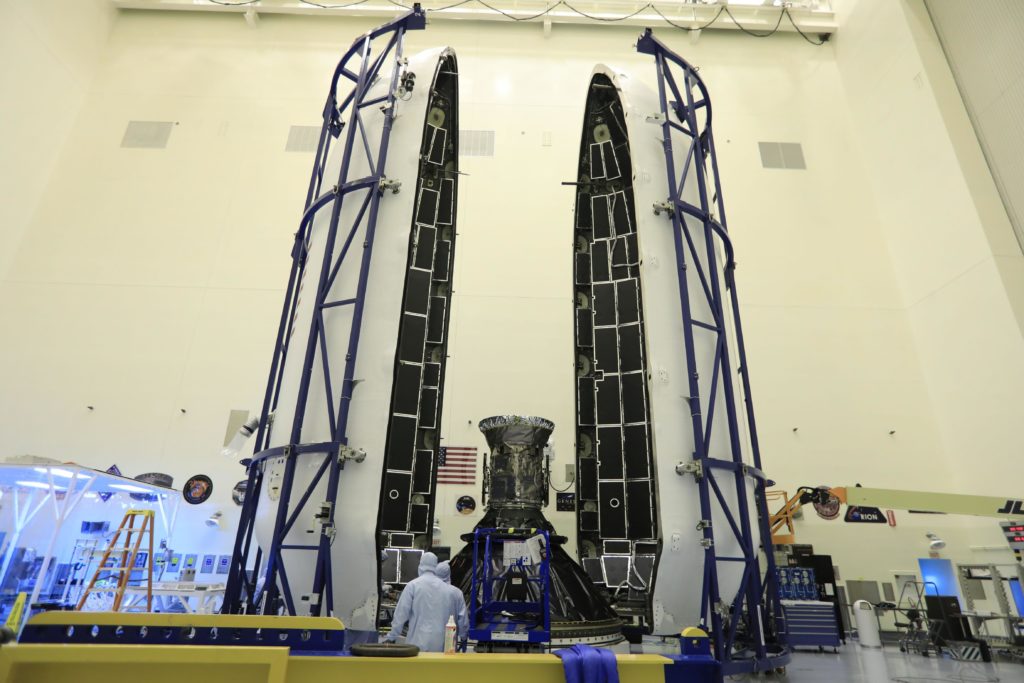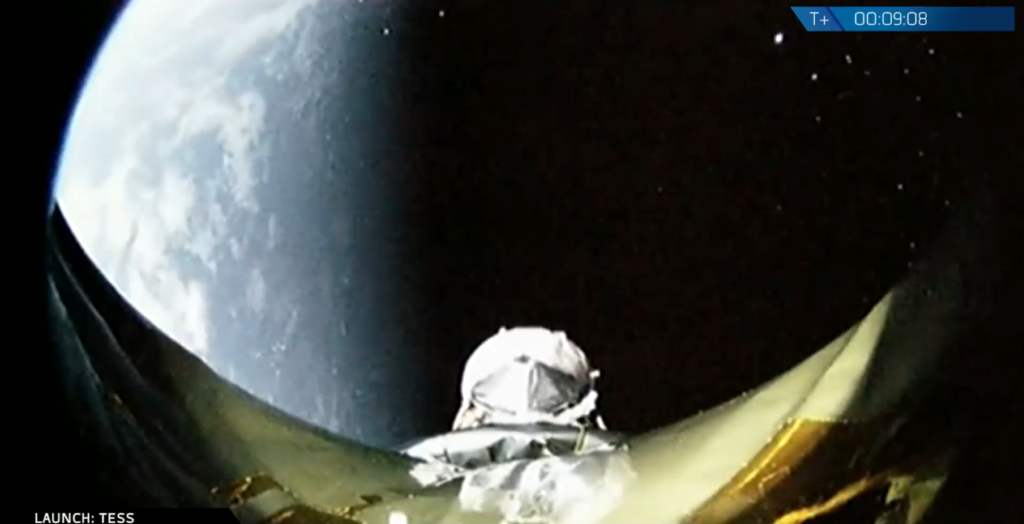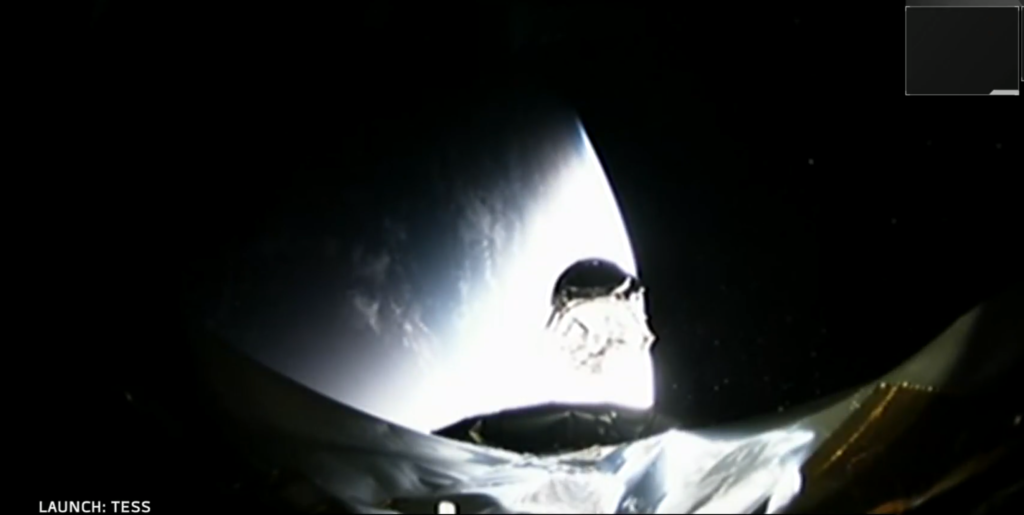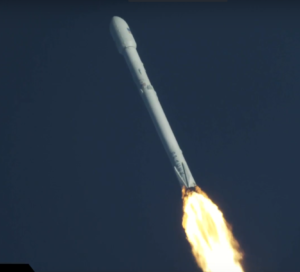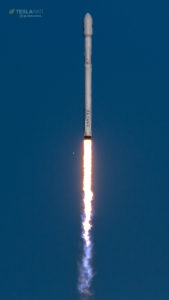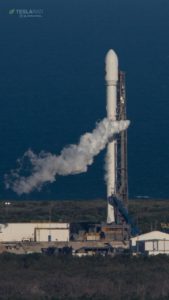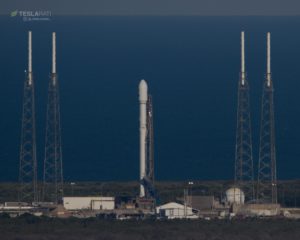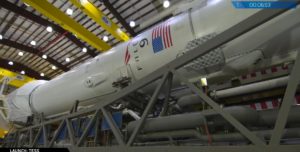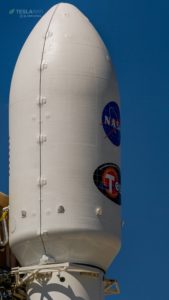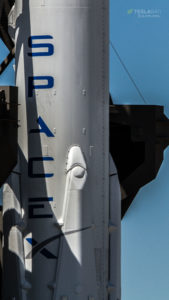
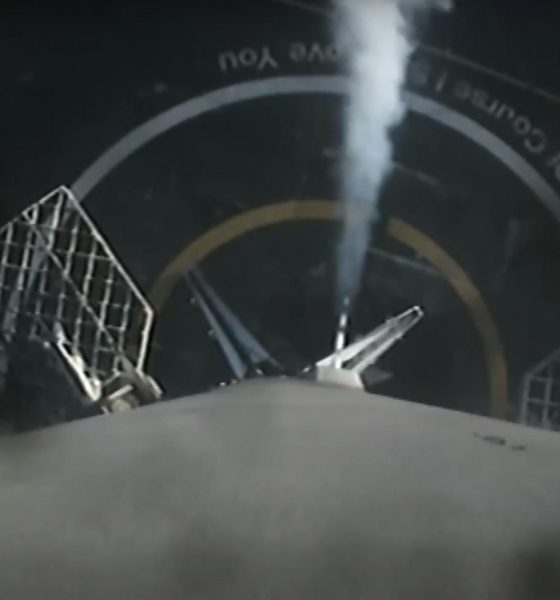
News
SpaceX nails first rocket landing by sea in half a year, sends exoplanet probe beyond the Moon
SpaceX has successfully completed the first drone ship recovery of a Falcon 9 booster in nearly six months, bringing to an end a what will likely be the final drought of by-sea rocket landings in the company’s history.
B1045’s landing was a particularly stunning example of just how far SpaceX has come. By all appearances, the recovery was easily the smoothest yet achieved by the company, with nary a hint of reentry heating visible in the near-flawless live coverage from a camera aboard the booster. Perhaps of even more interest, the landing itself appeared to be exceptionally luxurious, with the booster gently floating down to its final resting perch aboard the drone ship Of Course I Still Love You.
This return-to-landing, so to speak, is SpaceX’s 24th successful Falcon booster recovery in just over three years of true recovery efforts. The last several months have featured an unfamiliar number of intentionally expendable launches, in which SpaceX chose to preclude any attempt at recovery, instead typically gently landing the boosters in the ocean to gather additional flight-test data and to explore the envelope of Falcon 9’s recovery capabilities. In all cases but one (Hispasat 30W-6), these intentionally expended boosters were older, flight-proven versions of the rocket, versions that hadn’t been designed to economically fly more than once or twice.
B1045, however, has just one flight under its belt, and is already pegged for a second launch with CRS-15, giving the booster as few as 50 days to be refurbished and prepped for its second pre-launch static fire (likely the first week of June). This would be an exceptionally fitting case of foreshadowing for SpaceX’s upcoming Block 5 iteration of Falcon 9. If a Block 4 booster can be launched, landed, and refurbished in well under two months, one can only imagine what a Falcon 9 explicitly upgraded for ease of reuse will be capable of.
- Although SpaceX has nail multiple LZ-1 recoveries over the last six months, TESS is the first mission to feature a successful drone ship land since October 30 2017. (SpaceX)
- B1045 soars towards OCISLY, stationed 300 km East of the Florida coast. (SpaceX)
- Falcon 9 B1045’s picture-perfect, gentle landing aboard drone ship OCISLY, April 2018. (SpaceX)
Over the past six months, SpaceX has aggressively expanded their program of orbital rocket reuse, leaping from just three operational reflights of Falcon 9 boosters in the process’ first half-year (Mar-Oct ’17) to seven operational reflights between the following months of December and April. Today, April 18, the successful launch of NASA’s Transiting Exoplanet Survey Satellite (TESS) marks the final launch of a new Block 4 Falcon 9 booster (B1045) – although we can expect as many as three additional reflights of recovery Block 4 boosters in 2018, all new Falcon 9 boosters from here on out will be Block 5s, a final upgrade to the rocket designed to significantly optimize reliability and reusability. The first Falcon 9 Block 5 is expected to debut sometime in May, currently No Earlier Than (NET) May 4.
Impressively, despite the fairly extensive modifications and upgrades – both for reliability and reusability – included in Falcon 9 Block 5, SpaceX’s Hans Koenigsmann stated that the lengthy test campaign in Texas went well and was in fact “faster than we’ve ever had on new Block upgrades [of Falcon 9].” SpaceX themselves have not yet given a specific date for the debut of Block 5, but Hans did partially confirm recent reports that it is now targeting a debut in “early May” with the launch of Bangabandhu-1. Put simply, so long as things go more or less according to plan, 2018 will in every conceivable way usher in the real future of orbital-class reusable rockets – perhaps enabling the sort of responsive, cheap, and reliable access to space long ago promised by CEO Elon Musk.
Koenigsmann: This TESS booster is planned to fly again on the next CRS mission pending NASA approval. #SpaceX
— Michael Baylor (@MichaelBaylor_) April 15, 2018
Science galore
TESS will dramatically increase the number of known exoplanets. It will more than double the number found by Kepler. #NASA #TESS #SpaceX #Falcon9
— Chris G (@ChrisG_SpX) April 15, 2018
Despite its diminutive size and 350 kg mass, TESS is expected to dramatically expand the number of detected exoplanets in the universe, and is tasked with surveying the remaining 95% of the sky left unscanned after Kepler’s famous mission. Ultimately, conservative estimates from astronomers expect TESS to add thousands of new exoplanets to humanity’s current catalog, with perhaps as many as 10% of those discovered likely to be Earth-sized, and thus potential candidates for the first habitable planets to be observed beyond the cozy bounds of our own Solar System.
To give a sense of just how far electronics and satellite technology have improved in the decade since the Kepler observatory was launched (2009), that 1050kg spacecraft was designed to stare specifically at one small segment of the sky (0.25%), scanning it ceaselessly for exoplanets. Despite complex technical difficulties, Kepler managed to discover nearly 1100 confirmed exoplanets, with more than 3000 additional candidates waiting to be confirmed by other spacecraft or telescopes.
- A Falcon 9 fairing during encapsulation, when a launch payload is sealed inside the fairing’s two halves. This small satellite is NASA’s TESS, launched in April 2018. (NASA)
- Smol TESS seen attached to SpaceX’s Falcon 9 second stage. (SpaceX)
- Teeny, tiny TESS separates from Falcon 9’s second stage and begins its journey beyond the Moon, ahead of a productive life of science. (SpaceX)
On the other hand, the 350kg TESS, has been designed to sca the entire sky and may well double, triple, or quadruple the number of known exoplanets in the universe. Falcon 9 may undoubtedly be a bit like using a dump truck when a shovel would do, but the tiny size of the payload can be thanked for the exceptionally gentle booster recovery and the equally (relatively) easy refurbishment soon to follow.
- (SpaceX)
- (Tom Cross)
- (Tom Cross)
- (Tom Cross)
- Falcon 9 B1045 prepares for its first launch in mid-April. (SpaceX)
- SpaceX engineers and technicians have begun an aggressive campaign hoping to recover and reuse fairings ASAP. (Tom Cross)
- Falcon 9 B1045 before its first launch, carrying NASA’s TESS exoplanet observatory, in April 2018. (Tom Cross)
Follow us for live updates, behind-the-scenes sneak peeks, and a sea of beautiful photos from our East and West coast photographers.
Teslarati – Instagram – Twitter
Tom Cross – Twitter
Pauline Acalin – Twitter
Eric Ralph – Twitter

Cybertruck
Tesla updates Cybertruck owners about key Powershare feature

Tesla is updating Cybertruck owners on its timeline of a massive feature that has yet to ship: Powershare with Powerwall.
Powershare is a bidirectional charging feature exclusive to Cybertruck, which allows the vehicle’s battery to act as a portable power source for homes, appliances, tools, other EVs, and more. It was announced in late 2023 as part of Tesla’s push into vehicle-to-everything energy sharing, and acting as a giant portable charger is the main advantage, as it can provide backup power during outages.
Cybertruck’s Powershare system supports both vehicle-to-load (V2L) and vehicle-to-home (V2H), making it flexible and well-rounded for a variety of applications.
However, even though the feature was promised with Cybertruck, it has yet to be shipped to vehicles. Tesla communicated with owners through email recently regarding Powershare with Powerwall, which essentially has the pickup act as an extended battery.
Powerwall discharge would be prioritized before tapping into the truck’s larger pack.
However, Tesla is still working on getting the feature out to owners, an email said:
“We’re writing to let you know that the Powershare with Powerwall feature is still in development and is now scheduled for release in mid-2026.
This new release date gives us additional time to design and test this feature, ensuring its ability to communicate and optimize energy sharing between your vehicle and many configurations and generations of Powerwall. We are also using this time to develop additional Powershare features that will help us continue to accelerate the world’s transition to sustainable energy.”
Owners have expressed some real disappointment in Tesla’s continuous delays in releasing the feature, as it was expected to be released by late 2024, but now has been pushed back several times to mid-2026, according to the email.
Foundation Series Cybertruck buyers paid extra, expecting the feature to be rolled out with their vehicle upon pickup.
Cybertruck’s Lead Engineer, Wes Morrill, even commented on the holdup:
As a Cybertruck owner who also has Powerwall, I empathize with the disappointed comments.
To their credit, the team has delivered powershare functionality to Cybertruck customers who otherwise have no backup with development of the powershare gateway. As well as those with solar…
— Wes (@wmorrill3) December 12, 2025
He said that “it turned out to be much harder than anticipated to make powershare work seamlessly with existing Powerwalls through existing wall connectors. Two grid-forming devices need to negotiate who will form and who will follow, depending on the state of charge of each, and they need to do this without a network and through multiple generations of hardware, and test and validate this process through rigorous certifications to ensure grid safety.”
It’s nice to see the transparency, but it is justified for some Cybertruck owners to feel like they’ve been bait-and-switched.
News
Tesla’s northernmost Supercharger in North America opens

Tesla has opened its northernmost Supercharger in Fairbanks, Alaska, with eight V4 stalls located in one of the most frigid cities in the U.S.
Located just 196 miles from the Arctic Circle, Fairbanks’s average temperature for the week was around -12 degrees Fahrenheit. However, there are plenty of Tesla owners in Alaska who have been waiting for more charging options out in public.
There are only 36 total Supercharger stalls in Alaska, despite being the largest state in the U.S.
Eight Superchargers were added to Fairbanks, which will eventually be a 48-stall station. Tesla announced its activation today:
North America’s northernmost Supercharger Fairbanks, AK (8 stalls) opened to public. https://t.co/M4l04DZ6B5 pic.twitter.com/zyL6bDuA93
— Tesla Charging (@TeslaCharging) December 12, 2025
The base price per kWh is $0.43 at the Fairbanks Supercharger. Thanks to its V4 capabilities, it can charge at speeds up to 325 kW.
Despite being the northernmost Supercharger in North America, it is not even in the Top 5 northernmost Superchargers globally, because Alaska is south of Norway. The northernmost Supercharger is in Honningsvåg, Norway. All of the Top 5 are in the Scandanavian country.
Tesla’s Supercharger expansion in 2025 has been impressive, and although it experienced some early-quarter slowdowns due to V3-to-V4 hardware transitions, it has been the company’s strongest year for deployments.
🚨🚨 Tesla Supercharging had a HUGE year, and they deserve to be recognized.
🍔 Opened Tesla Diner, a drive-in movie theater with awesome, Chef-curated cuisine
🔌 Gave access to Superchargers to several EV makers, including Hyundai, Genesis, Mercedes-Benz, Kia, Lucid, Toyota,… pic.twitter.com/yYT2QEbqoW
— TESLARATI (@Teslarati) December 10, 2025
Through the three quarters of 2025, the company has added 7,753 stations and 73,817 stalls across the world, a 16 percent increase in stations and an 18 percent increase in stalls compared to last year.
Tesla is on track to add over 12,000 stalls for the full year, achieving an average of one new stall every hour, an impressive statistic.
Recently, the company wrapped up construction at its Supercharger Oasis in Lost Hills, California, a 168-stall Supercharger that Tesla Solar Panels completely power. It is the largest Supercharger in the world.
News
Tesla shocks with latest Robotaxi testing move
Why Tesla has chosen to use a couple of Model S units must have a reason; the company is calculated in its engineering and data collection efforts, so this is definitely more than “we just felt like giving our drivers a change of scenery.”

Tesla Model S vehicles were spotted performing validation testing with LiDAR rigs in California today, a pretty big switch-up compared to what we are used to seeing on the roads.
Tesla utilizes the Model Y crossover for its Robotaxi fleet. It is adequately sized, the most popular vehicle in its lineup, and is suitable for a wide variety of applications. It provides enough luxury for a single rider, but enough room for several passengers, if needed.
However, the testing has seemingly expanded to one of Tesla’s premium flagship offerings, as the Model S was spotted with the validation equipment that is seen entirely with Model Y vehicles. We have written several articles on Robotaxi testing mules being spotted across the United States, but this is a first:
🚨 Tesla is using Model S vehicles fitted with LiDAR rigs to validate FSD and Robotaxi, differing from the Model Ys that it uses typically
Those Model Y vehicles have been on the East Coast for some time. These Model S cars were spotted in California https://t.co/CN9Bw5Wma8 pic.twitter.com/UE55hx5mdd
— TESLARATI (@Teslarati) December 11, 2025
Why Tesla has chosen to use a couple of Model S units must have a reason; the company is calculated in its engineering and data collection efforts, so this is definitely more than “we just felt like giving our drivers a change of scenery.”
It seems to hint that Tesla could add a premium, more luxury offering to its Robotaxi platform eventually. Think about it: Uber has Uber Black, Lyft has Lyft Black. These vehicles and services are associated with a more premium cost as they combine luxury models with more catered transportation options.
Tesla could be testing the waters here, and it could be thinking of adding the Model S to its fleet of ride-hailing vehicles.
Reluctant to remove the Model S from its production plans completely despite its low volume contributions to the overall mission of transitioning the world to sustainable energy, the flagship sedan has always meant something. CEO Elon Musk referred to it, along with its sibling Model X, as continuing on production lines due to “sentimental reasons.”
However, its purpose might have been expanded to justify keeping it around, and why not? It is a cozy, premium offering, and it would be great for those who want a little more luxury and are willing to pay a few extra dollars.
Of course, none of this is even close to confirmed. However, it is reasonable to speculate that the Model S could be a potential addition to the Robotaxi fleet. It’s capable of all the same things the Model Y is, but with more luxuriousness, and it could be the perfect addition to the futuristic fleet.

